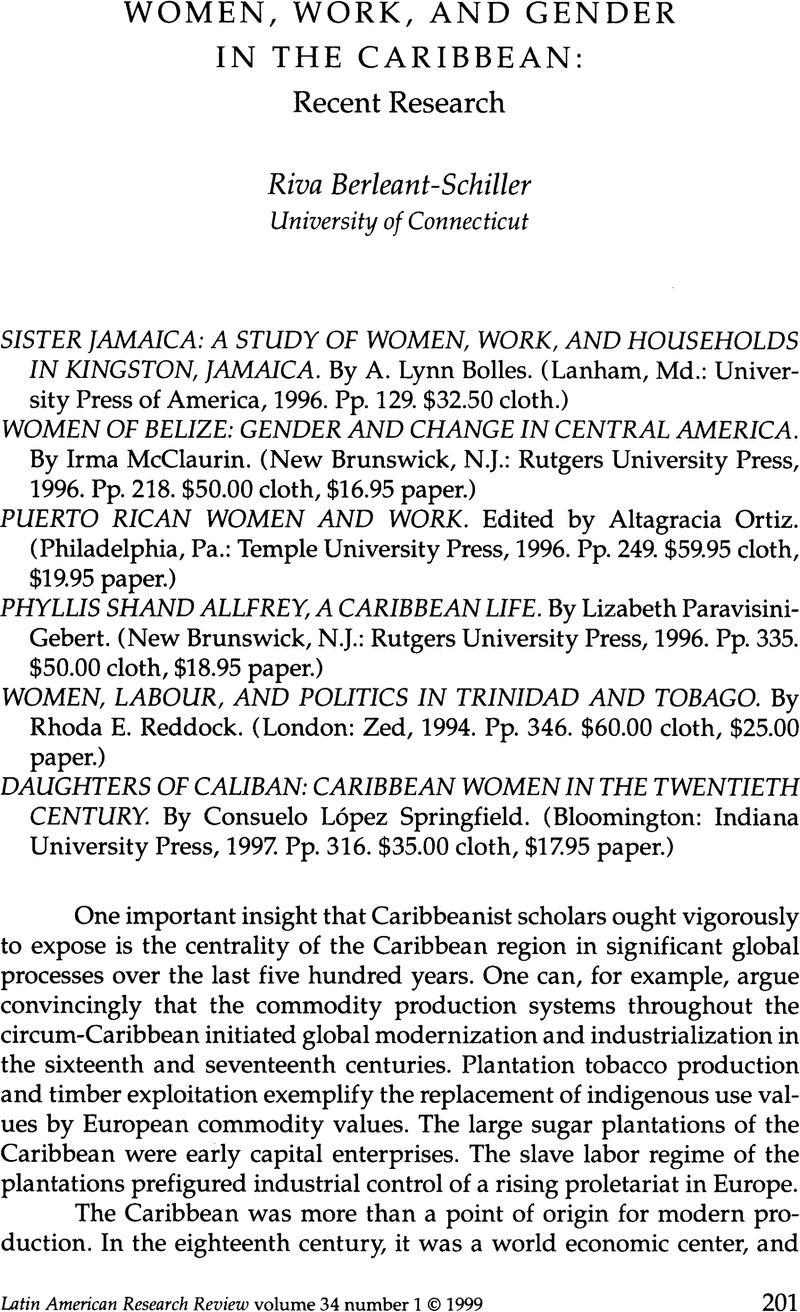Article contents
Women, Work, and Gender in the Caribbean: Recent Research
Review products
Published online by Cambridge University Press: 05 October 2022
Abstract

- Type
- Review Essays
- Information
- Copyright
- Copyright © 1999 by the University of Texas Press
References
Notes
1. Paul Farmer, AIDS and Accusation (Berkeley and Los Angeles: University of California Press, 1992), 161, 183.
2. Two examples from a large literature are Fernando Henriques, Family and Colour in Jamaica (London: MacGibbon and Kee, 1953, 1968); and T. S. Simey, Welfare and Planning in the West Indies (London: Oxford University Press, 1946).
3. The literature is too large to cite, but two classics are Edith Clarke, My Mother Who Fathered Me (London: George Allen and Unwin, 1957); and Raymond T. Smith, The Negro Family in British Guiana (London: Routledge and Kegan Paul, 1956). For a discussion of theory, see Christine Barrow, “Anthropology, the Family, and Women in the Caribbean,” in Gender in Caribbean Development, edited by Patricia Mohammed and Catherine Shepherd (Trinidad and Tobago: Women and Development Studies Project, University of the West Indies, 1988), 156–69.
4. See Olive Senior, Working Miracles: Women's Lives in the English-Speaking Caribbean (Bloomington: Indiana University Press, 1991). Senior includes a summary of the project, an excellent synthesis of its findings, and a useful bibliography.
5. Janet H. Momsen, Women and Change in the Caribbean: A Pan-Caribbean Perspective (Bloomington: Indiana University Press, 1993).
6. Sallie Westwood, All Day, Every Day: Factory and Family in the Making of Women's Lives (Bloomington: Indiana University Press, 1987).
7. Women of the Caribbean, edited by Patricia Ellis (London: Zed, 1986); Mohammed and Shepherd, Gender in Caribbean Development; Women and The Sexual Division of Labour in the Caribbean, edited by Keith Hart (Mona, Jamaica: Consortium Graduate School of the Social Sciences, University of the West Indies, 1989); and Momsen, Women and Change.
8. Michelle Rosaldo, “Woman, Culture, and Society: A Theoretical Overview,” in Woman, Culture, and Society, edited by Michelle Rosaldo and Louise Lamphere (Palo Alto, Calif.: Stanford University Press, 1974).
9. Three contributions to Momsen's edited volume, Women and Change, make this point: Christine Barrow's “Small-Farm Production and Gender in Barbados,” 181–93; Riva Berleant-Schiller and William Maurer's “Women's Place Is Every Place: Merging Domains and Women's Roles in Barbuda and Dominica,” 65–79; and Karen Fog Olwig's “The Migration Experience: Nevisian Women at Home and Abroad,” 150–66.
- 1
- Cited by




